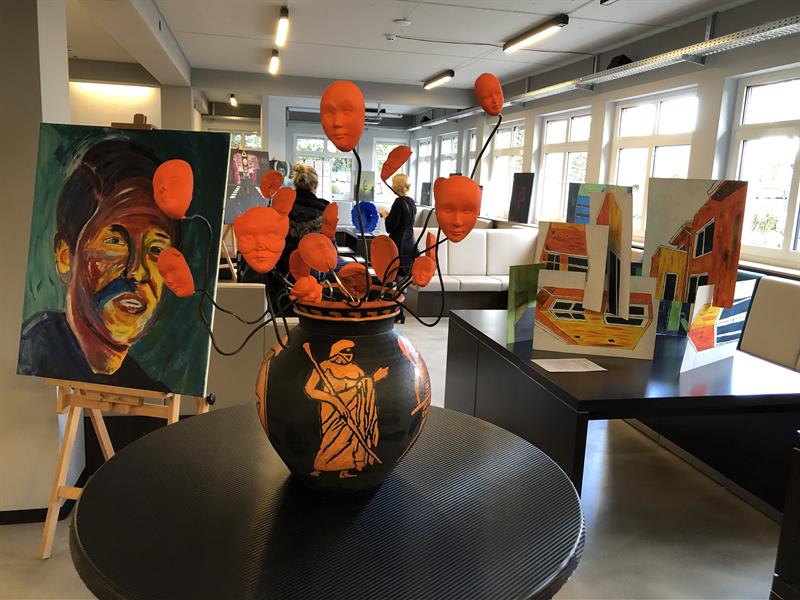Art and Design

Art and design are very different things that can often be confused in the collective imagination.
Both the designer and the artist can walk through the same environments, handle similar concepts and even share elements in their academic training, but their works and ends are completely different.
Although there are clear differences between what a designer seeks and what an artist seeks when creating a piece, for many people both professions are still used as synonyms for each other, even though they are completely different.
Surely you’ve heard it somewhere, there are designers who “didn’t risk” being artists and ended up in design. Other artists who later discovered that their passion was actually design. And there is never a lack of people, like me, who study communication, thinking that they can be both.
Besides, there are many types of artistic and design expressions. Most probably we think about painting and graphic design, and maybe this is the reason why many people get confused. But design goes beyond posters or advertisements. There is industrial design, interior design, fashion design and web design. Although it is actually industrial design that we usually forget, isn’t it?
If we take this into account, perhaps we can see more clearly the differences between art and design. However, as we already mentioned, we generally forget about industrial design and don’t take into account that we are interacting with design most of the time in our day-to-day life as opposed to art.
The reality is that there is no one area that is better or worse. Both serve different purposes and if you are thinking about being an artist or being a designer but you don’t know which way to go, or if you are thinking about hiring a designer but you don’t know if an artist suits you better, we tell you what the main differences are so you can choose what suits you best.
What is the difference between art and design?
We could write a thesis with this but broadly speaking, design and art serve different purposes.
There are people who consider that there are designs that can be considered artistic works and there are artists who end up being part of poster designs. There are also people who maintain that both are part of a whole or that there is no difference whatsoever.
However the differences between art and design are:
- The purpose for which they are created
- The way the audience interacts with them
- The role they play
- The skills of the performer
Art asks, design answers
When we say that art and design serve and are created for different purposes, it is because art is created from feelings while design is created to provide a solution to a communication problem.
What art seeks is only to inspire the viewer to question himself while design seeks an audience that listens to the message it is transmitting, which was previously made. This does not mean that the artist does not make art thinking about sending a message, on the contrary, there are those who believe that all artistic work is a criticism either to the system or against it, but if we think for example of a work by Bansky, who is well known for criticizing the system and our society, although what he is looking for with his work is to send a message, he is not describing what people should do with it, he is inviting reflection to question who we are as people or society.

Instead, design seeks to create a solution to a problem, which is how can we communicate this and clearly understand our message and what we expect the audience to do with it? Design is not interpreted, it is created to be consumed as it is.
And not only as a final product, from the moment of its creation the design complies with certain structures and processes that art does not. And I’m not saying that in art there are no rules like proportion or vanishing point or light, etc. I am saying that when we create art we are creating a piece from our internal desires using concepts that can help us better to re-interpret our reality but this is not merely necessary.
Instead in the design processes are fulfilled, or rather replicated in order to make our message reach the audience, or fulfill the function that needs to fill (and be a solution).
Do you remember that we always forget about industrial design? Well, this is a good time to remember, especially when we are talking about solutions.
An artistic work, as strange as it may seem to you, does not need to fulfill a function other than inspiring you to question (even if that is actually art or not). On the other hand, in design, the object or product does fulfill a function and is solving or filling a need. Think of a chair. As simple as this product may seem to you it fulfills a function, it allows us to be able to sit. There are different types of chairs for different needs, there are chairs for the outdoors, for the office, those used for events, those that actually serve the function of sitting but are really benches or armchairs, etc.
The fact that chairs already exist and are four-legged does not necessarily mean that more chairs and different styles cannot be created or designed, whether to meet the need to stylise the room or the customer’s taste, etc.
The way the audience interacts with them
We have already said that we interact with design all the time and that we react, interpret or consume art and design in different ways. Also that art can be subject to interpretation as opposed to design. That’s why there are people who say that art is a matter of taste and design is a matter of opinion. This may sound confusing because there are works of art that in our opinion are horrible or illogical.
When we go to an art gallery, or when we simply analyze a work of art anywhere, what we do is judge it according to our own standards. What if you found it grotesque, what if it didn’t inspire you, what if it’s just balls or sticks, etc. Our perception of what is good art or not is based or formed on our tastes, what we consume and what we appreciate above all.
In contrast, we say that in design it is a matter of opinion because you may not like a design or it may not look good but this does not mean that it is not functional. It doesn’t mean that it is fulfilling its objectives. Think about a promotional poster for food, how many times have we not come across posters that we don’t like and that were created by professionals? This is not about whether I like it or not, or whether I was inspired by it or not. In design the question is, did it do its job? Yes, then it’s a good design.

